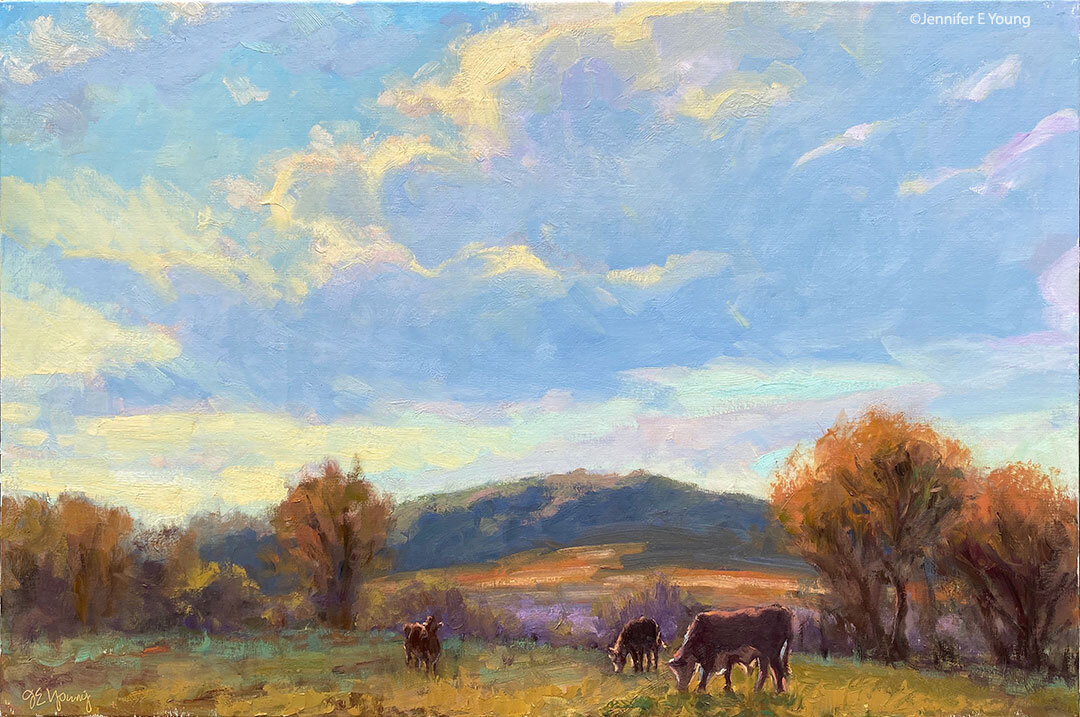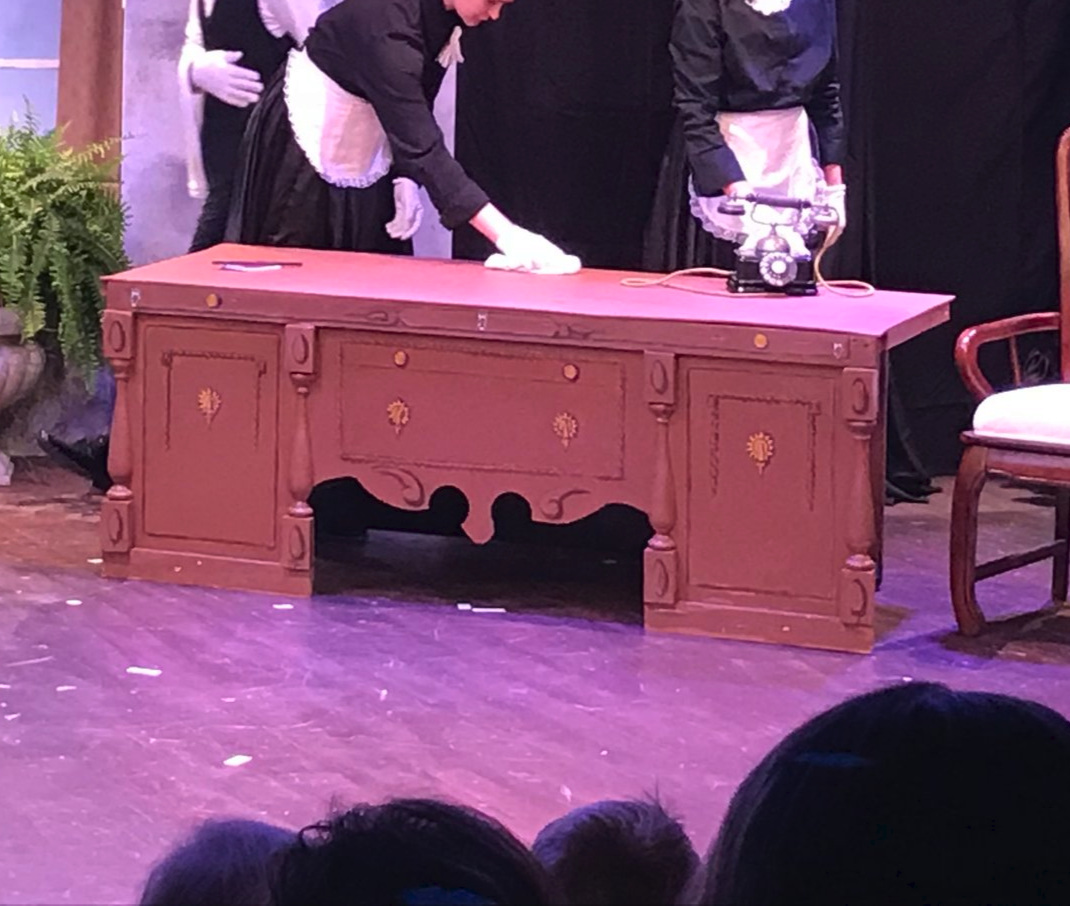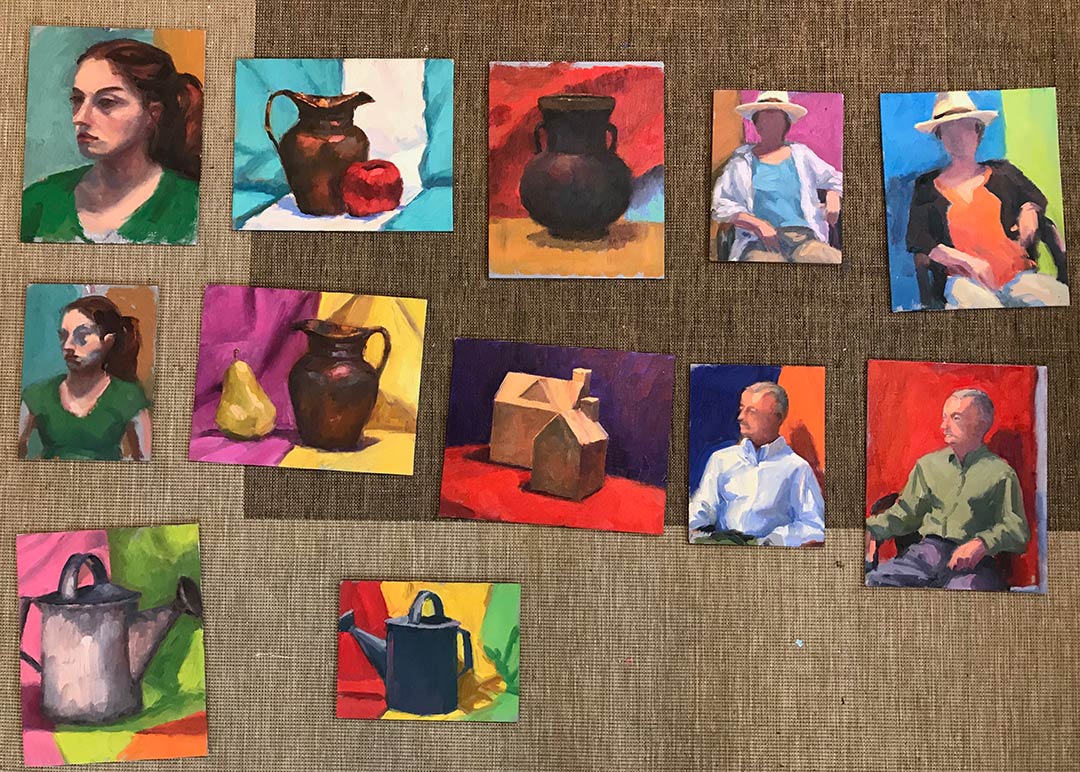This whole week I've been walking around telling myself that I was leaving for France in two weeks. What I realized today is that I'm actually leaving in a week. Ack! :-0 Yes, I have been known to fall down the worm-hole of time unless I am stringent about staying on a schedule. Many distractions at home have gotten me off of that lately, and here I am wondering where the time went! So since I've nothing much to say about the all the new work I've not done lately, I thought I'd still at least post something useful about traveling with art materials.
I've written about this before, but it always seems to take me off guard when I actually have to get down to deciding what I'll take and what I'll leave behind. I'll be traveling to a very rural part of France , (okay, so it's not the jungle! But art supply stores are generally hard to come by in the countryside), so I really want to try not to be in a position of "need' when it comes to my supplies and my gear.
At the same time, I can't pack "everything but the kitchen sink", because for this trip I will be traveling solo to and from my destination. My husband, who named himself "Le Pack Mule" during our travels abroad, is sitting this one out (I can't imagine why? ;-) ) This means I have to be able to carry everything without relying on batting eyelashes for assistance. I haven't fleshed out my complete supply list, but my obvious "must haves" are also the things that can cause the most weight-- the easel and the painting substrates. Since it's been pointed out to me that I've spent so much time lately talking about easels, I'll mix it up by addressing the substrates:
Lightweight but still archival
I'll be painting on location for anywhere from 7 to 10 days. I really have no idea of an exact itinerary, but I always try and plan for the max. It is certainly possible to buy canvases overseas, (Hello? France? Home of the Impressionists!) but the problem is that since we've never gotten on board with the metric system here in the U.S., I'd have to deal with custom framing each non-standard canvas once I got back home.
Canvas mounted on lightweight panel is a better option for travel than bulkier stretched canvas. In the past I've used birchboard. It's lightweight and compact compared to many other hardboard options (masonite, plywood, etc.), but if I consider that I may be painting two to four canvases each day, that's a whole lot of birch and the weight and volueme adds up fast.
Gatorfoam (gatorboard) is a great option, in that it is offered in archival form and is also one of the lightest supports available. It is basically a very, very strong foamcore board, offered in a variety of thicknesses.
 
Picture framers often use Gatorboard, and this is what a lot of plein air painters use as a support for primed linen or canvas. Cheap Joe's and other art supply stores sell various size sheets,  and there are also companies that specialize in making panels of this material. But even if you make your own panels with this material, it can be pretty expensive when you start to consider any amount of quantity, and then there is the bulk of carting it all overseas.
One of the newer materials on the market is Coroplast. Coroplast is essentially corrugated plastic, and like Gatorfoam, it is extremely lightweight. However, while not as inexpensive as plywood, Coroplast is more economical than the Gator.
 
Interestingly Coroplast seems also to be getting the archival nod, and a conservator for the National Gallery of Art has noted that it is virtually inert in terms of interference with the substrate. I've also found references to the use of Coroplast on art and museum conservator sites for packing and storing fine art. The biggest beef with Coroplast for a plein air panel seems to be the fluted corrugation between the sheets of plastic. The fear from conservators is that over time the canvas, if mounted directly onto Coroplast without an intermediate barrier, would adopt this same fluting texture.
...Enter Multimedia Artboard
Multimedia Artboard is another somewhat new material, designed to be an archival substrate for a variety of media from watercolor to acrylic to oil. I've seen several references to the use of this product by traveling plein air painters. This board is made of paper and epoxy resin and unlike canvas, it is rigid but extremely thin and lightweight:
 
It has a smooth side and a textured side, both of which can be painted on. For oil painting, the common practice seems to be to gesso the board for a less absorbant surface ( though the company claims compatibility with oils without gessoing) and then clamp, mount, or to tape it to a larger piece of coroplast or gatorboard for painting on site. Since this surface is pretty thin, it would need to be backed or mounted to some kind of board with an archival, reversable adhesive before framing.
I've ordered some of this Multimedia Artboard and have a funny story about it that I'll save for another time. I had hoped to experiment a lot with this material prior to my departure, but given my current life pattern this may not happen! So here's the plan: I'm taking a number of pieces of gessoed MMAB as well as pre-primed linen in various sizes; all of which I will tape or clamp temporaily to a larger firm support of Coroplast on location. (I'm going for the Coroplast because it won't dent if clamped- Gatorfoam might.) Any painting could then be backed or mounted in a more permanent way if I want to frame it up at home.
Supplies:
- Multimedia Artboard ( I chose 16x20 sheets, which could be cut down to a variety of sizes- 8x10, 11x14, 6x8, 9x12, 12x16, etc.) Sources:Â Multimedia ArtBoard's site, Jerry's Artarama, Dick Blick (to name a few)
- Gesso (for above- any art supply store)
- Primed linen canvas, (many sources for this) cut to size (allow about 2 inches on all sides if you want to stretch the canvas when you return home, or 1/4 to 1/2 inch all around for shrinkage if you intend to glue these to a panel.)
- One 14x18 or 16x20 inch Coroplast board to use as a firm support for paintings on location. Sources: Check local sign companies- they may be willing to sell blank sheets. Otherwise there are online suppliers for this.
- Painter's tape and/or clamps (for temporarily adhering substrate to support)
Don't feel like doing it youself back home? You can get prepared lightweight panels from commercial sources. Here are just a few:
Sourcetek
Wind River Arts
New Traditions Panels
Raymar (not as light as other options, but less costly and still much lighter than plywood. BTW- makes great, lightweight wet panel carriers out of --you guessed it! Coroplast!)






 I'm excited to have the opportunity to take a group there myself, for 10 days of painting, touring, eating, and just soaking in the atmosphere. Dates are June 3-13, 2009. This year during that time period I had word from the workshop host that the poppies were in full bloom and the roses were going crazy in the garden. I'm preparing my brochure now and should have it up on my website by next week. If you have an interest in joining me for this wonderful creative adventure, please check back, or just
I'm excited to have the opportunity to take a group there myself, for 10 days of painting, touring, eating, and just soaking in the atmosphere. Dates are June 3-13, 2009. This year during that time period I had word from the workshop host that the poppies were in full bloom and the roses were going crazy in the garden. I'm preparing my brochure now and should have it up on my website by next week. If you have an interest in joining me for this wonderful creative adventure, please check back, or just 


 In Virginia, if you dig deep enough, you will soon hit clay, which makes building any kind of new bed a bit of a chore, as you really have to work in a lot of good loose topsoil, soil conditioner, and fertilizer to make the plants take to it kindly. It kind of makes me shake my head a little when I visit places like the south of France. Roses practically grow out of the cracks of the sidewalks there! Okay, the gardeners there do have do deal with the rocks (and a lot of them) so I guess we all have our gardening challenges.
In Virginia, if you dig deep enough, you will soon hit clay, which makes building any kind of new bed a bit of a chore, as you really have to work in a lot of good loose topsoil, soil conditioner, and fertilizer to make the plants take to it kindly. It kind of makes me shake my head a little when I visit places like the south of France. Roses practically grow out of the cracks of the sidewalks there! Okay, the gardeners there do have do deal with the rocks (and a lot of them) so I guess we all have our gardening challenges.

 I really enjoyed this surface, especially for traveling and painting en plein air. For one thing, it is very thin, so you can pack a good number of these boards and not take up a ton of room in your suitcase. You can also cut the board to size very easily with either a guillotine-type paper cutter or an exacto knife.
I really enjoyed this surface, especially for traveling and painting en plein air. For one thing, it is very thin, so you can pack a good number of these boards and not take up a ton of room in your suitcase. You can also cut the board to size very easily with either a guillotine-type paper cutter or an exacto knife. "Le Pigeonnier"
Oil on Multimedia Artboard, 6x12"
"Le Pigeonnier"
Oil on Multimedia Artboard, 6x12"

 "The Flower Stand, Cahors Market, (France)"
Oil on Multimedia ArtBoard
"The Flower Stand, Cahors Market, (France)"
Oil on Multimedia ArtBoard

 Work in Progress (as yet untitled)
Oil on Linen, 11x14"
Work in Progress (as yet untitled)
Oil on Linen, 11x14"
 by Betty Lynch. (A quick look at the price that this book is now going for makes me glad that I got this as a gift!) Betty is a very talented watercolorist, but I am partial to her simple pen and ink sketches, and they inspired me to keep my own little art journal for my trip.
by Betty Lynch. (A quick look at the price that this book is now going for makes me glad that I got this as a gift!) Betty is a very talented watercolorist, but I am partial to her simple pen and ink sketches, and they inspired me to keep my own little art journal for my trip. I brought a 5x8" moleskine journal with me, which fit nicely into my carryall bag. Never one to be without as many options as possible, I chose the notebook that would accept watercolors (though most of my sketches were pen and ink.) Here's one with my notes of
I brought a 5x8" moleskine journal with me, which fit nicely into my carryall bag. Never one to be without as many options as possible, I chose the notebook that would accept watercolors (though most of my sketches were pen and ink.) Here's one with my notes of 


 Â
 
 Exterior of my "home" during my 10 day painting holiday.
Exterior of my "home" during my 10 day painting holiday.

 "Color Surprise"
Oil on Canvas, 6x8"
"Color Surprise"
Oil on Canvas, 6x8"










